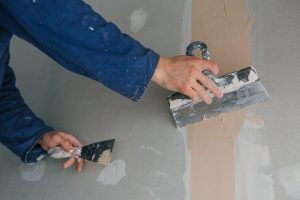-
When to Repair Plaster Ceiling: 10 Warning Signs to Watch
-
-
When should I be concerned about visible cracks and creases on my plaster ceiling?
-
What causes water stains or discoloration on a plaster ceiling?
-
How can I address peeling paint or wallpaper on my plaster ceiling?
-
Why is mold growth on the surface of a plaster ceiling a cause for concern?
-
Can unusual sounds coming from my plaster ceiling signal a problem?
-
Wondering when it’s time to fix that cracked plaster ceiling? In this listicle, we’ve got you covered with all the signs and tips you need to address home foundation problems. From identifying water damage to understanding structural issues, we’ll help you know exactly when it’s time to call in the repair squad. Plus, we’ll share some cost-effective solutions and DIY hacks for those minor home fixes that can save you a bundle.

Ready to say goodbye to those pesky ceiling cracks? Scroll down for reviews of our top picks on how to tackle plaster ceiling repairs like a pro!
Visible Cracks and Creases
Cracks and creases on your home’s plaster ceiling are not just cosmetic issues; they can signify deeper structural problems. These visible signs could be an indication of leaks, foundation damage, or roof issues that need immediate attention. Keep a close eye on any new or expanding cracks in the home as they might require prompt repair work to prevent further damage.
Regular inspection of your home’s ceiling is crucial to catch these warning signs early. By proactively looking for cracks and creases in the home, you can address the underlying issues before they escalate into more significant problems. Remember that even small fissures in the plaster layers could be a red flag for potential structural concerns.
When assessing your ceiling, consider the materials used in its construction. Different materials in a home may react differently to environmental factors, leading to varying types of damage like flickering paint or holes forming due to moisture seepage. Understanding these signs can help you determine the severity of the issue and decide on appropriate repair measures promptly.
Sagging or Bulging Sections
When you notice sagging or bulging areas on your plaster ceiling, it’s often a sign of underlying issues like water damage or weakened support. These changes can indicate structural problems that need immediate attention to prevent safety hazards.
Addressing a sagging ceiling promptly is crucial as it can lead to more significant damage if left unattended. By keeping an eye out for any noticeable changes in the shape or contour of your ceiling, you can catch potential issues early and take appropriate action to rectify them.

Remember that ignoring sagging or bulging sections on your plaster ceiling could result in costly repairs down the line. It’s best to address these concerns as soon as they arise to maintain the integrity and safety of your home environment.
Water Stains or Discoloration
Water stains or discoloration on your ceiling can be early warnings of potential issues. Dark spots are often indicators of water damage that should not be overlooked. Regularly checking for these signs is crucial to catch any problems early.
-
Early Detection: Water stains act as visible markers, signaling a possible leak or moisture concern.
-
Prevent Further Damage: Addressing these stains promptly can prevent more extensive water damage.
-
Maintenance Reminder: Checking for discoloration serves as a reminder to inspect the area and potentially avoid costly repairs later on.
Remember, keeping an eye out for water-related signs like stains is part of responsible homeowner maintenance. Being proactive in addressing such issues can save you time and money in the long run.

Mold Growth on the Surface
Mold growth on your plaster ceiling indicates a moisture issue and inadequate ventilation. This can not only damage your ceiling but also pose health risks due to the spores released into the air. Promptly addressing mold is crucial for maintaining a healthy indoor environment.
-
Signs of Mold: Look out for black, green, or brown patches on your ceiling as these are common indicators of mold growth.
-
Health Concerns: Exposure to mold can trigger allergies, respiratory problems, and other health issues.
-
Prevention Measures: Proper ventilation and controlling humidity levels in your home can help prevent mold from developing on your ceiling.
Remember that ignoring mold growth may lead to more extensive damage requiring costly repairs. Regularly inspecting your plaster ceilings for any signs of mold is essential in maintaining a safe and healthy living space.
Peeling Paint or Wallpaper
Peeling paint or wallpaper on your ceiling is more than just a cosmetic issue; it often signals deeper problems. This could be due to moisture seeping into the plaster, the natural aging process of materials, or even poor initial installation practices.
Addressing areas where peeling occurs promptly is crucial to prevent further damage to the plaster. Ignoring these signs can lead to larger sections of the ceiling needing repair and potentially higher costs down the line.
By taking action early on, you can preserve the integrity of your ceiling and avoid extensive repairs in the future. Regularly inspecting your ceilings for any signs of peeling paint or wallpaper can help catch issues early before they escalate.
Remember that fixing small problem areas promptly not only maintains the aesthetic appeal of your home but also safeguards against potential structural damage caused by neglected plaster problems.
Dust or Debris from the Ceiling
-
Accumulation of dust or debris falling from the ceiling indicates deterioration.
-
Loose particles may be a sign that the plaster is becoming unstable.
-
Regularly check for any unusual dust or debris coming from your ceiling.
When you notice an increase in dust or debris falling from your ceiling, it’s crucial to address this issue promptly. This could signify underlying damage to your plaster ceiling, potentially leading to more severe problems if left unattended. By staying vigilant and regularly inspecting for these warning signs, you can catch any issues early on before they escalate into costly repairs.
Remember that ceilings are not just decorative elements; they play a vital role in maintaining the structural integrity of your home. Any damage to the plaster ceiling can compromise its ability to support itself properly. Factors like water leaks, structural movement, or age-related wear and tear can all contribute to the deterioration of your ceiling material.
Neglecting signs of damage such as excessive dust or debris falling from above could result in safety hazards and further degradation of your ceilings over time. Act proactively by addressing these warning signals promptly with professional inspection and repair services tailored to restore the stability and aesthetics of your plaster ceilings.
Unusual Sounds from the Ceiling
Strange noises like creaking, popping, or cracking could indicate structural problems. These sounds are not typical and may signify underlying issues within the plaster ceiling. Pay attention to any new or persistent sounds coming from above.
Unusual noises should be investigated promptly to determine their cause and the necessary repairs. Ignoring these sounds can lead to more significant damage over time, potentially resulting in costly repairs. It’s crucial to address these auditory warning signs before they escalate into more severe issues.
Regularly monitoring for unusual sounds in your ceiling can help you catch problems early on and prevent further damage. If you notice any strange noises that persist or worsen, it’s advisable to consult a professional for a thorough inspection and recommended actions.
Difficulty in Opening Doors or Windows
If you find it hard to open doors or windows, it might signal a problem with your ceiling. Sagging ceilings can cause structural issues that affect the alignment of these openings. Any changes in how your doors and windows function could be linked to the condition of your ceiling.
For instance, excessive humidity levels can lead to plaster problems, resulting in movement within the ceiling structure. This movement can then impact the surrounding elements such as doors and windows. If left unaddressed, this issue could worsen over time and potentially cause failure in the functionality of these features.
Regularly inspecting your doors and windows for any unusual behavior can help you catch early signs of a sagging ceiling before it escalates into a major problem. Seeking professional help to repair plaster ceilings promptly can prevent further complications and ensure the longevity of your home’s structural integrity.
Noticeable Gaps Between Walls and Ceiling
Gaps between walls and the ceiling are red flags for potential plaster damage. These gaps can hint at underlying issues like settling or structural movements within the building. It’s crucial to examine any visible separations carefully.
-
Potential Damage: The presence of gaps suggests that there might be problems with the plasterwork, leading to uneven floors or cracks.
-
Structural Integrity: Uneven gaps could indicate more than just cosmetic issues; they may point to significant structural concerns that need addressing promptly.
-
Professional Inspection: Consider consulting a professional if you notice persistent gaps as they could signify deeper-rooted problems requiring expert intervention.

When to Repair Plaster Ceiling: 10 Warning Signs to Watch
Increased Heating or Cooling Bills
-
A sudden spike in energy bills might be a sign of poor insulation due to a damaged plaster ceiling.
-
Air leaks through cracks and gaps in the ceiling can lead to inefficient heating or cooling in your home.
-
Monitoring your energy usage can help you identify if unexpected bill increases are linked to ceiling damage.
If you notice that your heating or cooling costs are escalating without any changes in your usage patterns, it could be worth investigating the condition of your plaster ceiling. By addressing any issues promptly, you may not only improve the comfort of your home but also potentially save on future energy expenses. Regular maintenance and timely repairs can ensure that your house remains energy-efficient and comfortable throughout the year.
Energy efficiency is crucial for maintaining a sustainable and cost-effective household. Repairing a damaged plaster ceiling can contribute significantly to reducing unnecessary energy consumption, benefiting both the environment and your wallet over time.
Closing Thoughts
You’ve learned the signs that indicate your plaster ceiling might need some TLC. From cracks and bulges to water stains and mold growth, your ceiling can tell you a lot if you pay attention. Don’t ignore the warning signs; they could be costing you more than just repair bills. Keep an eye out for these red flags, and remember, a stitch in time saves nine!
So, if your ceiling is trying to tell you something, listen up. Take action before those small issues turn into major headaches. Your home deserves the best care, and by addressing these problems promptly, you can save yourself time, money, and stress in the long run. Remember, a little maintenance now can prevent a whole lot of trouble later on.
Frequently Asked Questions
When should I be concerned about visible cracks and creases on my plaster ceiling?
If you notice visible cracks and creases on your plaster ceiling, it’s time to take action. These signs indicate potential structural issues that may worsen over time if left unattended.
What causes water stains or discoloration on a plaster ceiling due to damp conditions?
Water stains or discoloration on a plaster ceiling are often caused by leaks from plumbing, roof damage, or condensation buildup. Addressing the source of the water intrusion is crucial to prevent further damage and mold growth.
How can I address peeling paint or wallpaper on my plaster ceiling?
Peeling paint or wallpaper on your plaster ceiling could be due to moisture issues. To fix this, you’ll need to identify and resolve the underlying cause of the moisture before repainting or reapplying wallpaper.
Why is mold growth on the surface of a plaster ceiling, roof, walls, and chimney a cause for concern?
Mold growth on a plaster ceiling not only indicates excess moisture but also poses health risks. Mold spores can affect indoor air quality and trigger respiratory problems. It’s essential to address mold promptly through proper removal and remediation.
Can unusual sounds coming from my plaster ceiling, walls, or doors signal a problem?
Unusual sounds like creaking, popping, or cracking coming from your plaster ceiling could signify structural issues such as sagging or stress. Consulting with a professional contractor can help identify the root cause of these noises and prevent potential damages.

